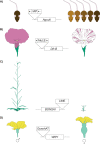Double-edged sword: The evolutionary consequences of the epigenetic silencing of transposable elements
- PMID: 32673310
- PMCID: PMC7365398
- DOI: 10.1371/journal.pgen.1008872
Double-edged sword: The evolutionary consequences of the epigenetic silencing of transposable elements
Abstract
Transposable elements (TEs) are genomic parasites that selfishly replicate at the expense of host fitness. Fifty years of evolutionary studies of TEs have concentrated on the deleterious genetic effects of TEs, such as their effects on disrupting genes and regulatory sequences. However, a flurry of recent work suggests that there is another important source of TEs' harmful effects-epigenetic silencing. Host genomes typically silence TEs by the deposition of repressive epigenetic marks. While this silencing reduces the selfish replication of TEs and should benefit hosts, a picture is emerging that the epigenetic silencing of TEs triggers inadvertent spreading of repressive marks to otherwise expressed neighboring genes, ultimately jeopardizing host fitness. In this Review, we provide a long-overdue overview of the recent genome-wide evidence for the presence and prevalence of TEs' epigenetic effects, highlighting both the similarities and differences across mammals, insects, and plants. We lay out the current understanding of the functional and fitness consequences of TEs' epigenetic effects, and propose possible influences of such effects on the evolution of both hosts and TEs themselves. These unique evolutionary consequences indicate that TEs' epigenetic effect is not only a crucial component of TE biology but could also be a significant contributor to genome function and evolution.
Conflict of interest statement
The authors have declared that no competing interests exist.
Figures



Similar articles
-
Species-specific chromatin landscape determines how transposable elements shape genome evolution.Elife. 2022 Aug 23;11:e81567. doi: 10.7554/eLife.81567. Elife. 2022. PMID: 35997258 Free PMC article.
-
Epigenetic silencing of transposable elements: a trade-off between reduced transposition and deleterious effects on neighboring gene expression.Genome Res. 2009 Aug;19(8):1419-28. doi: 10.1101/gr.091678.109. Epub 2009 May 28. Genome Res. 2009. PMID: 19478138 Free PMC article.
-
Epigenetic regulation of intragenic transposable elements: a two-edged sword.J Biochem. 2018 Nov 1;164(5):323-328. doi: 10.1093/jb/mvy060. J Biochem. 2018. PMID: 30010918 Review.
-
Epigenetic regulation and functional exaptation of transposable elements in higher plants.Curr Opin Plant Biol. 2014 Oct;21:83-88. doi: 10.1016/j.pbi.2014.07.001. Epub 2014 Jul 25. Curr Opin Plant Biol. 2014. PMID: 25061895 Review.
-
How transposable elements are recognized and epigenetically silenced in plants?Curr Opin Plant Biol. 2023 Oct;75:102428. doi: 10.1016/j.pbi.2023.102428. Epub 2023 Jul 21. Curr Opin Plant Biol. 2023. PMID: 37481986 Review.
Cited by
-
Prevalent Fast Evolution of Genes Involved in Heterochromatin Functions.Mol Biol Evol. 2024 Sep 4;41(9):msae181. doi: 10.1093/molbev/msae181. Mol Biol Evol. 2024. PMID: 39189646 Free PMC article.
-
Chromatin Landscape Dynamics in the Early Development of the Plant Parasitic Nematode Meloidogyne incognita.Front Cell Dev Biol. 2021 Dec 6;9:765690. doi: 10.3389/fcell.2021.765690. eCollection 2021. Front Cell Dev Biol. 2021. PMID: 34938734 Free PMC article.
-
Evolutionary dynamics between transposable elements and their host genomes: mechanisms of suppression and escape.Curr Opin Genet Dev. 2023 Oct;82:102092. doi: 10.1016/j.gde.2023.102092. Epub 2023 Jul 28. Curr Opin Genet Dev. 2023. PMID: 37517354 Free PMC article. Review.
-
Distinct composition and amplification dynamics of transposable elements in sacred lotus (Nelumbo nucifera Gaertn.).Plant J. 2022 Oct;112(1):172-192. doi: 10.1111/tpj.15938. Epub 2022 Aug 26. Plant J. 2022. PMID: 35959634 Free PMC article.
-
The Role of DNA Methylation in Genome Defense in Cnidaria and Other Invertebrates.Mol Biol Evol. 2022 Feb 3;39(2):msac018. doi: 10.1093/molbev/msac018. Mol Biol Evol. 2022. PMID: 35084499 Free PMC article.
References
Publication types
MeSH terms
Substances
Grants and funding
LinkOut - more resources
Full Text Sources

